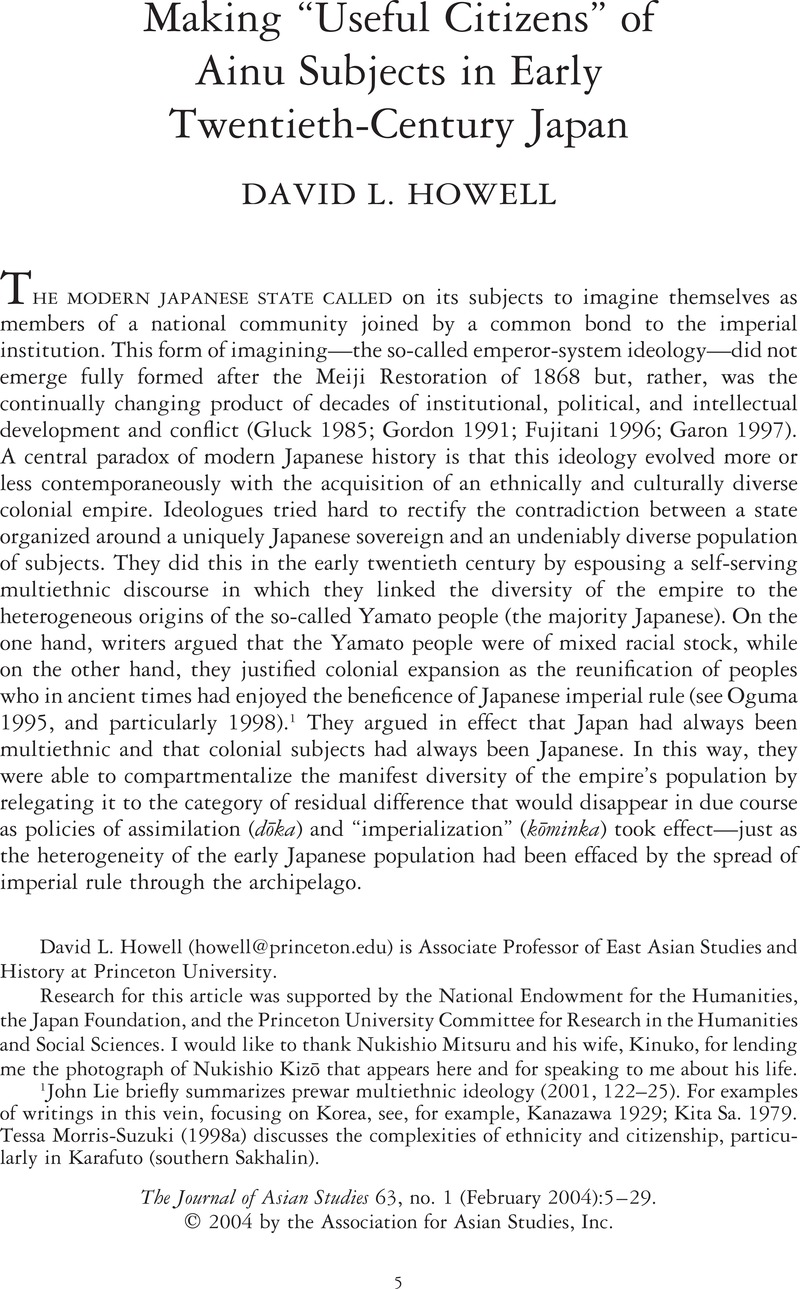Crossref Citations
This article has been cited by the following publications. This list is generated based on data provided by Crossref.
Cheung, Sidney C. H.
2005.
Rethinking Ainu Heritage: A Case Study of an Ainu Settlement in Hokkaido, Japan.
International Journal of Heritage Studies,
Vol. 11,
Issue. 3,
p.
197.
Henry, Todd A.
2005.
Sanitizing Empire: Japanese Articulations of Korean Otherness and the Construction of Early Colonial Seoul, 1905–1919.
The Journal of Asian Studies,
Vol. 64,
Issue. 3,
p.
639.
Chapman, David
2008.
TAMA‐CHAN AND SEALING JAPANESE IDENTITY.
Critical Asian Studies,
Vol. 40,
Issue. 3,
p.
423.
Hansen, Paul
2014.
Hokkaido’s frontiers: Blurred embodiments, shared affects and the evolution of dairy farming’s animal-human-machine.
Critique of Anthropology,
Vol. 34,
Issue. 1,
p.
48.
Ziomek, Kirsten L.
2014.
The 1903 Human Pavilion: Colonial Realities and Subaltern Subjectivities in Twentieth-Century Japan.
The Journal of Asian Studies,
Vol. 73,
Issue. 2,
p.
493.
2015.
Cold War Encounters in US-Occupied Okinawa.
p.
185.
lewallen, ann-elise
2016.
“Clamoring Blood”: The Materiality of Belonging in Modern Ainu Identity.
Critical Asian Studies,
Vol. 48,
Issue. 1,
p.
50.
Centeno Martín, Marcos P.
Goff, Loretta
and
Schroeter, Caroline V.
2017.
The fight for self-representation.
Alphaville: Journal of Film and Screen Media,
p.
69.
Hammine, Madoka
2019.
Sámi Educational History in a Comparative International Perspective.
p.
225.
Godefroy, Noémi
2019.
La minorité aïnoue dans le Japon moderne et contemporain. D’« anciens indigènes », de nouveau(x) autochtones (1869-2019).
Ebisu,
p.
255.
Uzawa, Kanako
and
Watson, Mark K.
2020.
Urespa (“growing together”): the remaking of Ainu-Wajin relations in Japan through an innovative social venture.
Asian Anthropology,
Vol. 19,
Issue. 1,
p.
53.
Meyer, Thomas George
2020.
Difference as privilege: identity, citizenship and the recontextualisation of human rights in Japan’s social studies curriculum.
Critical Studies in Education,
Vol. 61,
Issue. 1,
p.
17.
Komai, Eléonore
2022.
The Ainu and Indigenous politics in Japan: negotiating agency, institutional stability, and change.
The Journal of Race, Ethnicity, and Politics,
Vol. 7,
Issue. 1,
p.
141.
Howell, David L.
2023.
The New Cambridge History of Japan.
p.
603.
2023.
The New Cambridge History of Japan.
p.
441.
Simon, Scott
2024.
La situation coloniale et la résurgence autochtone en Asie du Nord-Est : Nukishio Kuzô, 2023 [1934], Assimilation et vestiges des Aïnous. Manifeste précurseur autochtone. Montréal, Presses de l’Université du Québec, coll. « Jardin de givre », 288 p.Dobashi Yoshimi, 2023, Penriuk et sa douleur. Ossements aïnous retenus prisonniers. Montréal, Presses de l’Université du Québec, coll. « Jardin de givre », 248 p..
Anthropologie et Sociétés,
Vol. 48,
Issue. 1,
p.
291.
Baber, Zaheer
2024.
‘Class and “Race”. . . the two antinomic poles of a permanent dialectic’: Racialization, racism and resistance in Japan.
Current Sociology,
Vol. 72,
Issue. 5,
p.
871.
Kovacic, Mateja
2024.
Between animated cells and animated cels: symbiotic turn and animation in multispecies life.
Science as Culture,
Vol. 33,
Issue. 2,
p.
174.
Keller, Zsófia
2025.
Ainu Representation in the World of Japanese Comics: Shumari and Golden Kamuy Take on the Ruling Narratives of Hokkaidō History.
Távol-keleti Tanulmányok,
Vol. 17,
Issue. 1,
p.
149.



